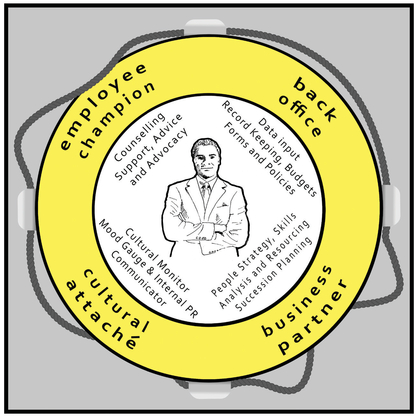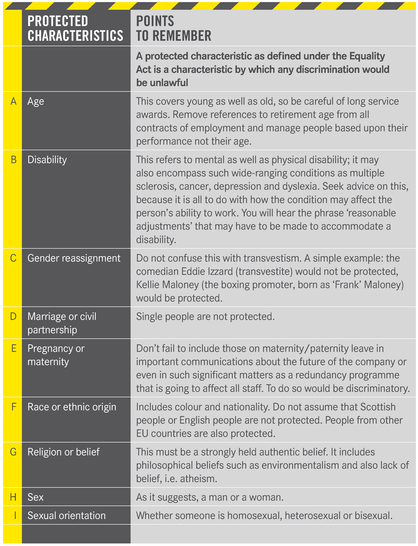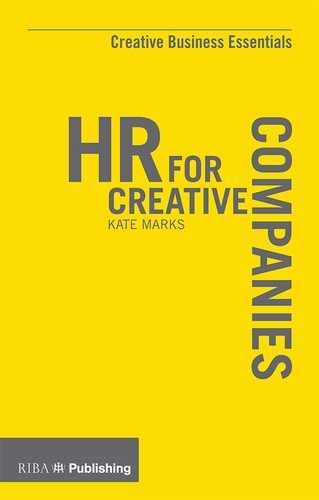02 What is HR?
WHAT IS HR?
It’s not an exaggeration to say that mentioning you work in ‘human resources’ at some kind of social event causes a reaction similar to saying you work as a tax inspector or a traffic warden. We often seem to be seen as a necessary evil. Many are the tales of incompetence, insensitivity, slowness and lack of commercial understanding. Most people have their own negative experience with HR, ranging from a slow recruitment process to an impersonal and insensitive redundancy process. George Clooney’s 2009 film, Up In The Air - in which the protagonist makes a living as the go-between who tells workers they have been ‘let go’ when their employers are unwilling to do it themselves - did us no favours.
There are a number of reasons why HR has a negative reputation and this is not the place for an in-depth examination of HR as a profession. Suffice to say that those whose role involves or whose job title includes HR can be from many backgrounds, with wide-ranging experience and with many or few qualifications in the field. HR as a professional career is relatively new. It has been through significant changes in the past few years and is now really coming into its own in proving the value that it can add to a company. It is beginning to be taken as seriously as finance, marketing and IT in boardrooms.
As a profession, HR has its house in order. It has a professional body, the Chartered Institute of Personnel and Development (CIPD). Basic membership is relatively easy, but the more senior levels of membership are only granted after proof of skills, qualifications and experience. This will all help to increase credibility over time. There is recognition that HR, when it is done well, is of immeasurable value to any company. We need more positive public relations because, love it or hate it, HR is here to stay.
However, it is likely that we will never be able to completely dispel the negative reputation. Who is it that will be involved with disciplinary matters, or performance management, or redundancies? Who is less likely to be involved with giving pay rises, or promotions, or handing out rewards? It is perhaps unsurprising that managers often like being involved with the positive aspects of dealing with people, but may delegate the aspects that are perceived to be negative.
Also, it will be an HR representative who is telling you when you can and can’t do something in order to maintain legal compliance; hence, ‘HR just keep telling me what I can’t do’.
HR specialists are rarely involved in helping to create business strategy and so often are simply implementing someone else’s plans whether they agree with them or not. They may feel a certain amount of resentment if they have no input into the decision-making process. This may come across as diffidence or defensiveness.
What we need to develop is a positive working relationship with HR. HR will watch your back in terms of legal compliance and warning you of likely legal challenges. HR will free you up to focus on your company’s core business and why you started it in the first place.
HR will still come in many forms - see below and take your pick - but try to ensure that their role is varied and they are engaged with you and the company.
Every company is different and will have different focuses for HR. The first step tends to be legal compliance in the form of documentation. This is often simply making sure that there is a reasonably up-to-date contract of employment template and some basic policies in place. Some more daring companies might even go straight for having a more comprehensive employee handbook with a wider array of policies.
The next step is often designing an appraisal system that is appropriate for the company: then some management training in interviewing skills and how to conduct a disciplinary or grievance meeting.
It’s very much a step-by-step process.
However, there remain many myths about what HR actually is or does.
I should allay any fears that this book is trying to teach you everything there is to know about HR; it is not. Instead, it will focus on what you need to know as owners, directors or managers of small and medium-sized creative companies. It will also guide you as to how to make the best use of HR within your organisation.
The Employee Lifecycle
Let’s begin by clarifying what HR is and what it covers. Many people still associate it with hiring and firing. This illustration should help to connect the two.

The employee lifecycle rather speaks for itself. It is a continuum from when the employee first approaches your company to apply for a job until they leave - and then perhaps return in the future to a new or similar role.
Recruitment (hiring) and release (firing) are certainly key aspects to what HR actually does. They are the main points at which the company interacts with the marketplace. How you choose to conduct these aspects of people management will tell the world much about your culture and ways of doing business. We will talk about the importance of your corporate brand in the next chapter, in relation to recruitment.
However, in terms of good practice and creating an environment where you have happy and productive staff, the points between recruitment and release are equally important. If your HR practices are not joined up and if they are inconsistent, they will be less effective and most likely more time consuming and therefore costly to you; not to mention opening up the possibility of problematic and even discriminatory practices. An example to which we’ll refer again later, is the job description. Consistency in the use of job descriptions throughout the employee lifecycle makes your expectations clear right from the start and should make your life easier because of that.
So, there are HR-related responsibilities relating to your staff members even before they start working for you and also when they have left your employment, and all points in between.
Recruit:
- > Attracting the best candidates that are right for your company
- > Managing the recruitment process and ensuring effective recruitment methods
- > Making offers of employment
- > Ensuring orientation and a smooth transition into your workplace
- > Managing the probationary period and being sure that it is used properly.
Reward:
- > Ensuring a fair and competitive remuneration structure
- > Resourcing a benefits package that reflects the company’s budget and ethos
- > Planning a clear articulation of what is rewarded in line with company culture and ethos.
Retain:
- > Putting into place a well-considered retention plan
- > Ensuring employee motivation and engagement
- > Managing professional learning and development, using appraisals and other tools.
Recognise:
- > Helping to articulate the basis for promotion
- > Driving management training and leadership development
- > Assisting in succession plans.
Release:
- > Assisting in performance management plans
- > Leading the disciplinary (and grievance) procedures
- > Managing dismissals and redundancy programmes
- > Supervising exit interviews and the resignation process
- > Dealing with matters relating to former staff such as references and benefits.
The HR Skills Portfolio
There are many tasks and roles that come under the umbrella of HR. In larger organisations, the HR department can be huge and encompass a vast array of specialist HR functions: recruitment; training and development; compensation and benefits; employee relations; health and safety; reward and recognition; leadership/management development; and so on. In a smaller organisation, you may have only one person who is responsible for HR and who may also be carrying out other roles. In some of the smallest organisations, it is likely to be the managing director/senior partner/ owner in conjunction with their PA/ secretary/office administrator who does everything.
It is probable that a high proportion of SMEs will engage with an HR generalist rather than a series of specialists. An HR generalist, as the name suggests, has chosen not to specialise and so provides a broad range of services encompassing most of the functions relevant to the employee lifecycle.
The various roles that an HR generalist may need to adopt during their career can include:
- > Sales – recruitment is as much about selling as buying; HR will be the first port of call and may be the first interaction that potential new recruits have with your company
- > Counsellor – HR often provides the first port of call for issues that employees are experiencing, both personal and professional
- > Hatchet wielder – leading dismissal procedures and redundancies
- > Police officer – ensuring that the company operates towards its employees within the legal framework
- > Negotiator – whether it be negotiating a good deal with benefits providers, training companies or managing an angry director who just wants to dismiss a poorly performing staff member: ensuring risk is managed by following a proper process
- > Teacher – designing and delivering training or providing mentoring and guidance to managers in HR practices.

Back office: This is the administrative aspect of HR – inputting data, monitoring holiday and sickness absence, providing forms, explaining policies, managing budgets. It requires accuracy and a love of detail and process.
Business partner: This is how the people strategy fits in with the business strategy; making sure that there are the available skills in the company to fulfil business needs; resourcing, development and succession planning.
Cultural attaché: This person walks among the staff members, assessing the culture and how it is evolving, managing the myths and legends of the company; the conduit between management and staff.
Employee champion: This person provides counselling and support, guidance, mentoring, advice and information; ensuring fair and consistent business practices.
As you can imagine, each of these roles requires different strengths and characteristics. A successful HR professional has to be something of a chameleon. They need to be good at data input, figures and detail; to be sensitive, emotionally intelligent and able to put themselves in other people’s shoes; to be pragmatic, business focused, commercially aware and a strategic thinker. HR professionals also need to know when to be flexible and when to stick to their guns. This variety provides both the challenge and the fascination for this profession.
Building Your HR Capacity
I’ve often been asked for my advice on creating the ideal HR department. The answer will vary considerably from company to company.
The process should begin with taking a look at what resources you already have within the company. Someone among the staff may have legal knowledge, or training expertise. But if you are genuinely starting from scratch, there are a number of ways you can obtain the expertise that you need. I’ve already mentioned smaller companies where the MD’s PA/office manager may fulfil the function. If you have only four or so staff, you really don’t need a full-time HR expert. When you hire your first administrative staff member, make sure they are organised, intelligent, willing to learn, conscientious and thorough in their work. This will cover most of the clerical aspects of HR, such as personnel filing, employee information maintenance, sickness and holiday records, and so on. You can use external experts for support. This may be an HR consultant or occasionally an employment lawyer. You may also find that a consultant can provide some coaching in basic HR practice so that you can see the internal body of knowledge developing.
As you grow, you may feel the need for a part-time HR specialist and ultimately a full-time HR manager.
SMEs will be served well by an HR generalist. It is relatively rare for a creative company to have the resources or need for a department of specialists. Even working for a company with a few hundred people, a senior HR generalist, supported by a recruitment specialist, a training and development specialist, and a good administrator, worked well for me.
The responsibility for HR within smaller organisations will usually be shared between an HR representative and the managers. The representative will offer advice, guidance and support, but it is the managers who work with their staff on a day-to-day basis, who will know them best and who can be more sensitive to their individual motivations and needs. This is a partnership. HR will enable and facilitate; managers will manage people.
The Legal Bit
When this book was first mooted, it was agreed that the legal aspects of HR were best dealt with in specialist texts – and they have been, most ably. However, there are certain key points which it is almost impossible to avoid when discussing HR. These particularly relate to the Equality Act.
Much of this Act underpins all that HR professionals do, because it’s all about treating people fairly and consistently. If you don’t, you are likely to fall foul of the Equality Act and all that it contains.
There are two main aspects of the Act that you need to be aware of and which you should remember as you take a look at the rest of this book: protected characteristics; and types of discrimination.
Let’s keep it as simple as possible.
There are nine protected characteristics and seven different types of discrimination. The key points are summarised in the tables below.
If you treat all your employees, potential employees and former employees fairly and consistently, the issue of discrimination and the spectre of the Equality Act need not arise. Keep these tables listing the protected characteristics and types of discrimination to hand as a useful reference in all your dealings with people.
It’s also good to keep a check on your own attitudes and behaviour from time to time to be sure you are not inadvertently crossing the line. We are all subjects of our own prejudices and filters, but it is important to be aware of them and not apply them within the workplace.


Current Employment Market
At the time of writing, the employment market in general is at the most interesting it has been for a long time. We appear to be emerging from what was, conceivably, the most challenging period in the life of many creative companies, especially those related to the built environment. So many companies have experienced redundancies, reduced hours and reduced salaries, cuts in training budgets, and the lack of productivity that fear for the future and insecurity can bring. Hence, the recovery has not been as bullish as it might have been in the past. It’s almost like an animal emerging from hibernation blinking into the sunshine. There seems to be a hesitancy to make impulsive decisions, and a tendency towards rather more close deliberation and research before making a move.
There are perennial themes regarding HR and employment: these include the search for talent, hiring and developing the right people for your company, succession planning, and leadership. In some ways these are melded together, in that there appears to be a desire to get the best out of the existing staff – so, an increase in performance management measures and plans with a view to improving the skills and productivity of a team or finding a way to terminate their employment.
This is not to say that recruitment is not taking place. Certainly, the recruitment market is rather more buoyant as we move into the second half of the decade than it has been for some time; but seems to be more orientated around seeking specialist skills or strategic hires. It is widely reported that, although there are people seeking work, and increasing mobility from the European Economic Area (EEA) and other countries outside the UK, companies are trying to hang on to their good staff and so there is a mismatch between talent available and talent sought. We read in the newspapers that UK employees are the least productive in Europe and this concern is reflected in the apparent drive to develop the most well-rounded, multi-skilled, efficient and effective employees possible.
Developing your HR practices to echo these new priorities will enable you to achieve your goals. Read on!
